 |
| No! Rupert refused to do his chores.... |
 |
| He would pull the girls long hair.... |
 |
| Spitballs..... |
 |
| Visits to the Principal's office he did not like at all.... |
 |
| One day a new girl came to school.....and things changed......boy did they change! |
 |
| No! Rupert refused to do his chores.... |
 |
| He would pull the girls long hair.... |
 |
| Spitballs..... |
 |
| Visits to the Principal's office he did not like at all.... |
 |
| One day a new girl came to school.....and things changed......boy did they change! |
Today marks the 1st day of National bullying prevention month. I am often asked at what age should we talk to our kids about bullying and related behaviors. I am pleased to share that many pre-schools and early learning centers have asked me to read my books to their students and talk to parents about pro-social education. It is never too early to teach our kids to be kind. To share with them the importance of caring about others and to try to use practical examples to allow them to work on compassion development. As many of you know I have my own little tot and we are already working on feelings identification exercises. Bookstores and resource stores like Self-esteem shop carry many tools to begin this process. If we can teach young people early how to recognize emotions it is a great step in the process of pro-social learning. Does your center need assistance? Can your family benefit from a personal consultation on emotional understanding and prevention? Please let me know. This Friday I will be at Kindercare centers reading my picture book series to students and beginning the process of pro-social education. If you need an Unbully kit we send great resources through the mail that includes information, tools and resources that aid in prevention. -Read something great
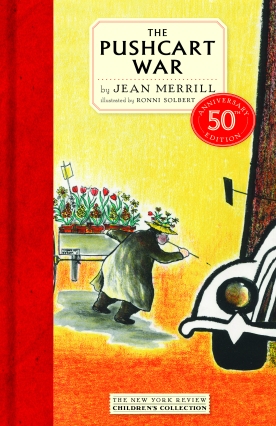
The Pushcart War: 50th Anniversary Edition
Written by Jean Merrill
Illustrated by Ronni Solbert
The New York Review Children’s Collection 9/16/2014
978-1-59017-819-5
Age 8 to 12 230 pages
x
x
“Do you know the history of the pushcart war? The real history? It’s a story of how regular people banded together and, armed with little more than their brains and good aim, defeated a mighty foe.”
Opening
“The Pushcart War started on the afternoon of March 15, 2026, when a truck ran down a pushcart belonging to a flower peddler.”
The Story
The Pushcart War began on a normal New York City day. The streets were jammed with cars, taxis, and delivery trucks that ranged from the normal size to the mammoth trucks with tires large than your car. It was taking up to four hours to travel four city streets. Tempers are running high, especially for Mack, a truck driver, who, despite his parents being pushcart peddlers, hated pushcarts. That day, with pure intention, deliberately ran into Morris the Florist (no known relation). Thanks to Marvin Seeley’s photo of the onset of the Daffodil Massacre, we know how the war started.
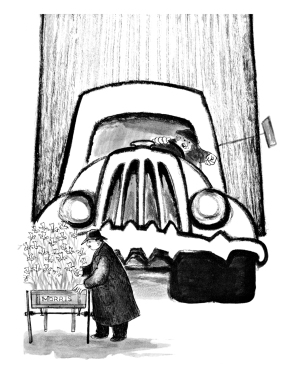 The trucks don’t want the pushcarts on the road and blamed them for the congestion. For some reason, these light, tiny, carts bothered the heavy, huge trucks. The peddlers couldn’t let the attack of Morris the Florist go unanswered, but lacked the funds the truck companies enjoyed. instead of a major affront, the peddlers decided to use pea shooters and pins to deflate the trucks tires, causing mass congestion and anger people to the point of voting trucks off city streets. For a while it worked and no one could figure out how the tires all went bad within minutes of each other. Until a mechanic found a pin.
The trucks don’t want the pushcarts on the road and blamed them for the congestion. For some reason, these light, tiny, carts bothered the heavy, huge trucks. The peddlers couldn’t let the attack of Morris the Florist go unanswered, but lacked the funds the truck companies enjoyed. instead of a major affront, the peddlers decided to use pea shooters and pins to deflate the trucks tires, causing mass congestion and anger people to the point of voting trucks off city streets. For a while it worked and no one could figure out how the tires all went bad within minutes of each other. Until a mechanic found a pin.
A single pin, or many pins does not reveal the culprit. One the newspapers ran the story, children began shooting truck tires for fun, unwittingly taking up the cause for the pushcart peddlers. Unfortunately, Frank the Flower was spotted and arrested for killing a truck tire with a pea shooter. He confessed to all 18,991 flattened tires.
“All 18,991?” asked the Police Commissioner as if he had not heard correctly the first time.
“I cannot be sure down to the last tire,” said Frank the Flower. “But I have been at it several days now.”
“But 18,991 tires!” Aid the Police Commissioner.
“It was nothing,” said Frank the Flower.
Well, kids took up the cause and to stop them the city began taxing tacks, which made the British upset since they are the world’s top producers of tacks. This got Washington involved. New York City becomes embroiled in the Pushcart War, though this name is not used yet. The Big Three Truck Companies: Leaping Lemas, Mighty Mammoths, and Tiger Trucking held a secret meeting to wipe out the pushcarts and the Pushcart King. What will happen to New York City in 2026? Will the pushcarts survive? Will the British calm down? Will Frank the Flower, who single-handedly killed 18,991 truck tires, ever leave his jail cell? What will happen to Mack, the trucker who put Morris the Florist into the hospital and started the war?
“The Big Three,” comprised of three delivery truck firms LEMA (Lower Eastside Moving Association) also called “Leaping Lemas,” and Tiger Trucking or “Tiger Trucks,” and Mammoth Moving, which used three sizes of trucks: Baby Mammoth, Mama Mammoth, and the Mighty Mammoth. These are the bullies of the story. For once, the bullies are not too big to fail.
The Pushcart War is a fun read. The humor is terrific and kept me groaning and laughing every few pages. The pushcart peddlers are a colorful bunch of characters especially The Pushcart King. The name to Maxie Hammerman because he fixes all of the pushcarts or builds new ones from scratch and is the only one in New York City capable of making the pushcarts correctly. When the trucking bullies decide to kidnap and dispose of The King—thinking he is the mastermind behind the campaign to rid the city streets of their trucks—Maxie has a surprise of his own. This is one of the best scenes of the story. It felt like I was reading the script from the movie called The Sting.
Kids will enjoy this futuristic farce of a “true tale.” The author casts herself as the futuristic novelist reporting on The Pushcart War ten years after the dust has settled and people are ready to hear about the war once more. City kids play a large part in the war, keeping the mayor and police commissioner completely puzzled. Written in 1964, the author envisions a New York City sixty years down the road. I find it interesting that there is no grand technology like cell phones and computers. The biggest difference is the extremely crowded streets, excess number of delivery trucks, and prices remaining similar, if not lower than the prices of her current time. (Apples are 5 cents).
The Pushcart War has style. The illustrations are black and white line art similar to what one would find in a newspaper only upgraded several times over. I love the illustration of Frank the Flower shooting his peashooter for the first time and Mr. Jerusalem who, after struggling over the morality of shooting truck tires, finds he is not only a terrific shot but enjoys his mission. Mr. Jerusalem quickly becomes the top tire executioner.
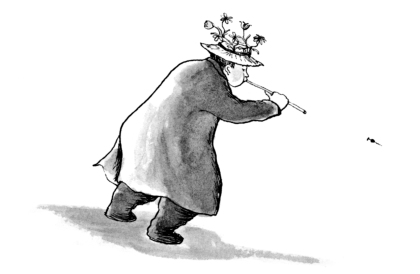 The Pushcart War is a classic tale of the big bully taking on the little guy and finding the littlest guy can outsmart, outthink, outwit the big dumb bully with grace and class. It should be required reading for every middle grade student. There is a little sociology, psychology, criminology, and a few other “ologies” worth reading. I love The Pushcart War.
The Pushcart War is a classic tale of the big bully taking on the little guy and finding the littlest guy can outsmart, outthink, outwit the big dumb bully with grace and class. It should be required reading for every middle grade student. There is a little sociology, psychology, criminology, and a few other “ologies” worth reading. I love The Pushcart War.
THE PUSHCART WAR. Text copyright © 1964/1992 by Jean Merrill. Illustrations copyright © 1964/1992 by Ronni Solbert. Reproduced by permission of the publisher, New York Review of Books, New York, NY.
x
Buy The Pushcart War at Amazon—B&N—Book Depository—New York Review of Books—your favorite bookstore.
Learn more about The Pushcart War HERE
Meet the author, Jean Merrill, from New York Times: http://www.nytimes.com/2012/08/12/books/jean-merrill-childrens-book-writer-dies-at-89.html?_r=0
Meet the illustrator, Ronni Solbert, from NYRB: http://www.nybooks.com/books/authors/ronni-solbert/
Find more classics at The New York Review Children’s Collection website: http://www.nybooks.com/books/imprints/childrens/
The New York Review Children’s Collection is an imprint of The New York Review of Books: http://www.nybooks.com/
x
Also by Jean Merrill and Ronni Solbert
x
x
Copyright © 2014 by Sue Morris/Kid Lit Reviews
Virgil Creech Takes a Swipe at Redemption
written by Mark Myers
published by Mark Myers 12/19/2013
978-0-61587615-3
Age 8 to 13 222 pages
.
“Welcome to the sleepy little town of Portsong, Georgia where there is a struggle a foot. Unbeknownst to the current owner, Virgil Creech has his selfish eyes set on taking back a dog he considers his. To be fair, as the youngest of nine bickering and bustling brothers, Virgil has always had to fight for the few things he could call his own. In this case, the property in question ran away from Virgil several months prior and now wants nothing to do with the boy, for he has found a happy home with the kindly Colonel Clarence Birdwhistle. Undetered, Virgil teams up with reluctant friend, Henry Lee, to retrieve the dog.”
Opening
“That was a mark!” yelled Henry as he disappeared behind the row of elm trees to round up the ball.”
The Story
Four friends, Virgil, Henry, Willy, and Joe are playing in the town green (like a park) when Virgil kicks the ball hard and too high hitting Colonel Birdwhistle in the back of the head, knocking him out onto the pavement. The boys cautiously check to see if he is alive and Virgil accidentally causes Birdwhistle to hit his head again, knocking him cold. Later, at the hospital, Willy and Joe check on Birdwhistle and leave believing the boys have caused Birdwhistle to become blind. Willy, Joe, and Henry decide to find a dog, train it as a Seeing Eye dog, and give him to the Colonel.
At the city dump, the boys find a dirty, matted, and awful smelling mongrel. Henry gives the dog a half-hour session in leading the blind, and then takes the dog to the hospital, leaving it in Birdwhistle’s room. The Colonel takes the mutt home, cleans him up, and decides to keep him. The dog, now named Oscar, is now a happy dog.
Virgil realizes Oscar his is dog and is mad that Birdwhistle stole the dog from him. According to Virgil, Birdwhistle came right into his house and took Bertie (same dog, different name). Virgil is determined to get his dog back and enlists the help of his one friend, Henry Lee. Henry is determined to keep Virgil sway from Oscar. To complicate matters, a nationwide contest for a trip to Africa gets the town, including Virgil, up in a tizzy. Virgil knows he is the winner and must just wait for the day his name is called. When he returns from Africa, he will then get his dog back. But Colonel Birdwhistle has been entered hundreds of times by townsfolk who appreciate and admire him. Birdwhistle wins, causing Virgil to believe the Colonel has now stolen two things from him. He is madder than two Creech boys fighting over a chicken drumstick are. How will Henry contain Virgil and keep Oscar safe and with Birdwhistle. Can he do it?
Review
Virgil Creech Takes a Swipe at Redemption tells the story of two boys, Virgil, Henry, a British transplant, and the man’s dog, Oscar. Virgil is a mean boy, the last of nine boys. Not a day goes by that he is not beat or taken advantage by one of his brothers. In turn, Virgil always has a chip on his shoulder, beats up kids at school, must always get his way, and has no friends. Virgil’s temper is as short as a temper can possibly be. Henry is a kind, well-mannered boy from a fine family. After Virgil kicks a ball that knocks-out Colonel Birdwhistle, the boys, especially Henry and Virgil, are thrown together for survival.
The well-planned and well-written story will keep you turning the pages. The author understands the psyche of the twelve-year-old boy and offers explanations and comments throughout the book. At first, I thought these annoying, but as more and more pages turned, the narrative became more natural, the comments regarding boys in general became interesting, and the story became a smooth ride, except for the Virgil bumps along the way. Packed with humor, tender moments, and upheaval only two young boys can cause, Virgil Creech Takes a Swipe at Redemption will please adults as well as kids.
I enjoyed the story, which focused more on Henry and his life than on the main character, Virgil. As one reviewer has already pointed out, Henry should be the protagonist. Virgil is a perfect antagonist and causes most of Henry’s stress. Once Henry understands how Virgil treated his dog and how the dog ended up living in the city dump, he vows to keep Oscar with the Colonel. Even Oscar stays away from Virgil, refusing to go anywhere he can smell the boy—which is not hard for anyone to do. At one point, the author states that Virgil is the only Creech that did a selfless act. Not so, the two brothers who rescued Bertie (Oscar in a former life), and cared for the dog, albeit in a dump, thought only of the dog, not themselves. Seems any Creech could have a heart deep within his chest.
There are no illustrations in the story. Oscar is a small dog, one that Henry can easily pick up. The dog on the cover is not small. I do like the angry hate-the-world scowl on Virgil’s face. This accurately portrays the boy’s disposition. While reading the story, Colonel Birdwhistle looked very near the image on the cover. The houses seem out of place for an area of town filled with green grass. Maybe on the other side they would be correct. Having saidall that, for someone who has not read the story, the cover is inviting and makes you want to know what the scamp on the cover has done.
I am not overly fond of the trick Birdwhistle and George, Henry’s father, plays on the town when Birdwhistle decides not to accept the trip he won, without entering himself. I like the first part, but what is the difference, as Henry asks, between leaving for three months and hiding out, without your dog, for three months. The Colonel does not want to leave the town, where he feels accepted and a member of nearly every family, yet he is still gone from the children and the story hour Birdwhistle did not want to miss. It would have made more sense for the Colonel to feign an illness. The author wanted a twist that would delight the reader but I think this failed to hit the mark.
Kids who love adventure or family-spun stories will enjoy Virgil Creech Takes a Swipe at Redemption. For his first book, Myers offered readers a well-crafted story, less the twist. There is a second Virgil Creech story to be released this Fall. I cannot wait to find out what bothers Virgil enough to make his face “glow red.” It is entitled, Virgil Creech Sings for His Supper. There is no preview, so make of this title as you will. Just the idea of Virgil singing scares me.
For a middle grade boy’s perspective of Virgil Creech Takes a Swipe at Redemption click HERE.
VIRGIL CREECH TAKES A SWIPE AT REDEMPTION. Text copyright © 2013 by Mark Myers.
To purchase your copy of Virgil Creech Takes a Swipe at Redemption go to Amazon—B&N—Book Depository—Author’s Website—your favorite bookstore.
Learn more about Virgil Creech Takes a Swipe at Redemption HERE.
Meet the author, Mark Myers, at his website: https://portsong.wordpress.com/
.
.

m
m
copyright © 2014 by Sue Morris/Kid Lit Reviews
m
 m
m
Don’t forget! Evil Fairies Love Hair releases AUGUST 5th. As a reminder, the review is HERE.
Get it at Amazon B&N Book Depository Clarion
Book: Abuelo
Author: Arthur Dorros
Illustrator: Raul Colon
Pages: 32
Age Range: 4-8
Abuelo by Arthur Dorros, illustrated by Raul Colon, is a quiet picture book about the relationship between a boy and his grandfather. They live somewhere in the country, where they ride horses, camp, and encounter wildlife. Later, the boy and his parents move to the city, leaving Abuelo behind. However, the skills that Abuelo has taught the boy (such as standing his ground) come in handy in his new life, too.
Dorros blends English and Spanish words in the text, including translations for key words and phrases. Like this:
"We would ride into the clouds,
with the sky, "el cielo,"
wrapped around us."
and this:
At night, we could see forever.
"Mira", look, he would tell me,
reaching his hands to the stars."
Even after the boy moves to the city, he still includes the Spanish translations for the things that he sees, though he perhaps does this a bit less.
Colon's watercolor and colored pencil illustrations are warm and deeply textured, cast in desert palettes of browns, grays, and sage green. There's a nostalgic feel to the pictures - this is a book that could be set now or 40 years ago. My favorite illustration is that one at the end of the book. The boy rides a bike, with the shadow of his Abuelo riding alongside him. I can't describe it, but Colon captured this perfectly.
Abuelo is about family and culture, moving away and growing up. It's a book that introduces readers to a different environment, while touching on universal truths (the fear of getting lost, the need to stand up to bullies). Abuelo is well worth a look, particularly for library purchase.
Publisher: HarperCollins (@HarperChildrens)
Publication Date: April 22, 2014
Source of Book: Review copy from the publisher
FTC Required Disclosure:
This site is an Amazon affiliate, and purchases made through Amazon links (including linked book covers) may result in my receiving a small commission (at no additional cost to you).
© 2014 by Jennifer Robinson of Jen Robinson's Book Page. All rights reserved. You can also follow me @JensBookPage or at my Growing Bookworms page on Facebook.
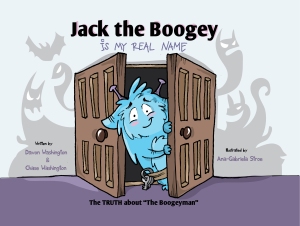 Jack the Boogey is My Real Name: the Truth About “The Boogeyman”
Jack the Boogey is My Real Name: the Truth About “The Boogeyman”
by Chase and Davon Washington & Ana-Gabriela Stroe, illustrator
Bedford House Books 2014
978-0-9960916-0-2
Age 4 to 8 34 pages
.
“It takes a lifetime to build a reputation, but only a second to lose it. Why is it that we are so quick to judge before giving people (or monsters in this case) the benefit of the doubt? There is nothing that feels more wonderful than being recognized for all of your hard work. However, when that recognition does not come, does it make the task a hand any less important? Sometimes the very thing that we are scared to encounter can be the thing that moves us forward. Facing a fear can mean the difference between failure and success. With that in mind, we thought that a good place to start would be with the wrongfully accused “Boogeyman.”
Opening
“A long time ago, someone called me the Boogeyman, the name stuck. Maybe I should take the time to formally introduce myself . . . I’m Jack the Boogey.”
The Story
Jack the Boogey, protector of children’s sleep, is a monster. Yes, monsters haunt children by living under their beds, hiding out in closets, and maybe even tickling them and then hiding when the child wakes up afraid of the dark. Those monsters are afraid of Jack the Boogey. Jack is the night patrolman who keeps children’s dreams from becoming nightmares. Nasty monsters do not like Jack. Jack ruins all of their nighttime fun. So what is a scary monster to do? Unionize.
One fateful night, Jack the Boogey was hiding in a closet waiting for monsters to shoo away, when a bad monster showed up. Jack pounced on the monster, but there were more, many more. The monsters were waiting for Jack, and they had a plan. Instead of running, the monsters turned on the bedroom lights, screamed, and then ran. The two children awoke, saw Jack, and then they screamed. Jack tried to explain, but it was useless. Jack the Boogey was now Jack the Boogeyman.
The next day, the two frightened kids told their friends all about the monster Jack the Boogeyman, their friends told their friends, those friends told their friends, and now friends are telling their friends and will until there are no friends left to tell that Jack, is the Boogeyman. From that night on, while monsters ruined kids’ sweet dreams, Jack stayed home in bed, depressed. Would Jack ever return to protect his charges? Will monsters continue to harass children, scare them silly, and make them scream until they can no longer utter a sound? How many more nights will children make parents look into closets and under beds looking for the elusive monsters?
Review
The Boogeyman. Definition: an imaginary monster that causes fear, especially in children; regarded as hateful, evil, or frightening; an imaginary evil creature used in stories for frightening children.
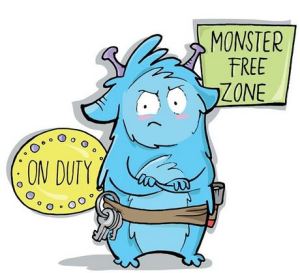 Jack the Boogey is NOT the Boogeyman. Monsters maliciously maligned dear Jack. They wanted him out. As in gone. Permanently. They settled for inflicting anguishing mental pain that so debilitated Jack that he became bedridden and depressed. Yes, some monsters are very frightening. Jack is not one of them. Not many know about boogies, nor how they protect children and adults. I did not know. Nor did I know that a gang of marauding monsters had bullied Jack. Yet they did. Kids will enjoy learning of Jack the Boogie.
Jack the Boogey is NOT the Boogeyman. Monsters maliciously maligned dear Jack. They wanted him out. As in gone. Permanently. They settled for inflicting anguishing mental pain that so debilitated Jack that he became bedridden and depressed. Yes, some monsters are very frightening. Jack is not one of them. Not many know about boogies, nor how they protect children and adults. I did not know. Nor did I know that a gang of marauding monsters had bullied Jack. Yet they did. Kids will enjoy learning of Jack the Boogie.
The illustrations of Jack and the monsters look cartoonish. Best not to scare children. The monsters do not look as scary as many of them are. Again, best for children. Jack the Boogey-man is a pale blue little guy with rosy cheeks, bright white eyes with small pin-point pupils, and two purple horns atop his head. Before the attack, Jack wore a constant smile that radiated from rosy check to rosy cheek. He looked like a janitor with his key ring hanging off his belt. If he ever wore pants and bent down, well, you get the picture. Jack was harmless except toward monsters. The real monsters that tear apart sweet dreams, hide under beds, and cause mayhem.
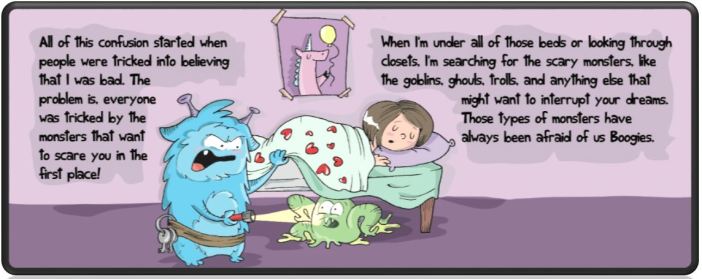 The one negative is the end pages. Instead of adhered to the inside front and back covers, they flap in the air as additional pages. Poor planning in the constructions phase.
The one negative is the end pages. Instead of adhered to the inside front and back covers, they flap in the air as additional pages. Poor planning in the constructions phase.
Jack’s story is difficult to believe, but kids will immediately understand and empathize with Jack. Bullies are the same, be they in a schoolyard or in a dark bedroom, late at night. The monsters easily fooled the frightened children who immediately told their friends to be careful. Of course, as time went on, the story of Jack the Boogeyman became embellished, and now hoards of children and adults are afraid of boogies, the very monster sent to protect them from monsters. It is a shame really, but the story needed told.
There is a redemptive moment for Jack. He misses the quiet breathing of sleeping children and hates the sound of their screams. Eventually he decides protecting youngsters—and some of us older kids—is more important that his bruised ego and returns to duty, much to the distress of many really scary monsters. Jack puts others before himself, does the right thing, and deflates his bruised ego. The monsters, who had become arrogant, once again run from boogies like Jack.
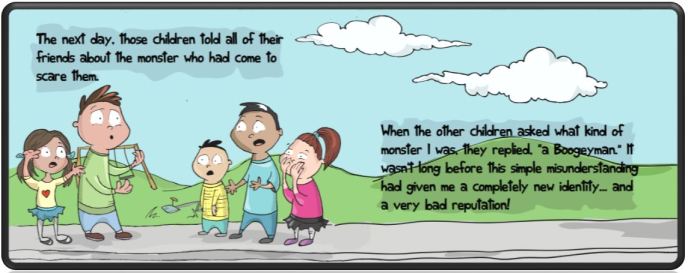 Jack the Boogey is My Real Name is the debut children’s book for both authors and illustrator. The story is imaginative but a bit wordy, yet easy to read aloud. It will become a nighttime favorite. Right before parents drop to their knees for an under-the-bed monster check. Jack has a mission statement and an official wallet identification card. He is the real deal of imaginary monsters. You’ll never see him as he protects you, but he is there. Young children going through the monster phase may feel comforted when reading about Jack and his protection skills. Nothing in the story is scary or nightmare inducing, making it the perfect anti-monster remedy.
Jack the Boogey is My Real Name is the debut children’s book for both authors and illustrator. The story is imaginative but a bit wordy, yet easy to read aloud. It will become a nighttime favorite. Right before parents drop to their knees for an under-the-bed monster check. Jack has a mission statement and an official wallet identification card. He is the real deal of imaginary monsters. You’ll never see him as he protects you, but he is there. Young children going through the monster phase may feel comforted when reading about Jack and his protection skills. Nothing in the story is scary or nightmare inducing, making it the perfect anti-monster remedy.
JACK BOOGEY IS MY REAL NAME: THE TRUTH ABOUT “THE BOOGEYMAN.” Text copyright © 2014 by Chase and Davon Washington. Illustrations copyright © 2014 by Ana-Gabriela Stroe. Reproduced by permission of the publisher, Bedford House Books, Brooklyn, NY.
Buy Jack the Boogey is My Real Name at Amazon—B&N—Bedford House Books—your local bookstore.
.
Learn more about Jack the Boogey is My Real Name HERE.
Meet the authors, Chase and Davon Washington, at their website: http://www.jacktheboogey.com/
Meet the illustrator, Ana-Gabriela Stroe, at her blogs: http://cargocollective.com/fluffylefluff http://blog.gessato.com/2011/08/05/around-the-world-with-ana-gabriela/
Find more books at the Bedford House Books website: http://bedfordhousebooks.com/
Ana-Gabriela Stroe’s portfolio: http://www.dailyinspiration.nl/the-portfolio-of-ana-gabriela-stroe/
.
.

Guess what? From now until the end of the month, I’m going to be giving away one free copy of the DOGGIRL audio book every day! That’s ten free audio books. I know! I mean it!
To enter to win, just send me a note here on my contact page telling me one quick story about you and your love for animals. It can be a childhood memory, a quick story about a favorite pet of yours, or just an overall description of why animals make our lives so much better. Keep it short (I do have other work to do), but tell me.
That’s it! I’ll pick one winner every day and send you the secret code to download the book from Audible.com.
Sound easy? Of course it is. So go for it!
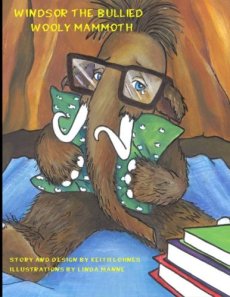 .
.
Windsor The Bullied Wooly Mammoth
by Keith Lohnes
Linda Manne, illustrator
978-0-98949110-5 8/13/2013
Age 6 to 9 72 pages
Amazon Author Description (unedited)
“Walking home from school alone, Windsor the Wooly Mammoth was startled to hear the shouting. Looking up, peering at him from a stone perch, was a mean Tyrannosaurus Rex named Trevor. At that moment, Windsor discovered the shouting was directed at him. The cruel words poked like tiny pins all over Windsor’s body. Why would someone say cruel things to me? I haven’t done anything to him! Windsor did his best to scurry away as fast as possible while all of his friends at school looked on in astonishment. Feeling trapped, alone and isolated, Windsor was confused at Trevor’s behavior. The story takes a turn when Windsor’s best friend Marvin steps into (sic) help. Marvin was concerned that Windsor did not know how to deal with Trevor’s bullying. Being a quiet, shy Mammoth, Windsor didn’t want anyone to know what was happening. Marvin knew better. Identifying the bully and immediately dealing with the events is the only way to make it stop. So Marvin enlisted the help of his friends and went to speak to Trevor about his bullying. In the beginning Trevor was very defensive. Over time however, Trevor began to understand that being a bully made him look bad and treating others poorly was not good for himself or anyone else. As the story and the characters evolve, bullying becomes evident. The resolution is for everyone to come together to prevent the behavior. In the end, Trevor discovers Windsor is a pretty nice Mammoth and they become great friends.”
Opening
“All the other Dinosaurs liked t play in the field after school, except for Winsor the Wooly Mammoth.”
The Story
Windsor loved to read so much that instead of playing with friends after school he reads. On the way home from school, Trevor yelled mean things at Windsor, called him names and threatened to knock his glasses off his face. Windsor was “a geek” because “all you do is read.” Windsor ignored Trevor, but still felt frightened. Trevor’s words and his taunting made Windsor feel bad about himself. The other young dinosaurs said nothing to Trevor. Some even laughed along with him. No one did a thing to help Windsor.
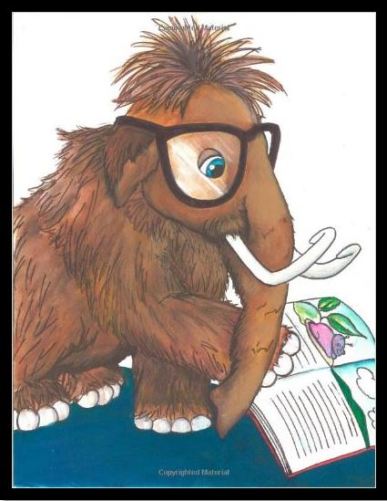
Everyone knew Windsor liked to read Jurassic Book, a dinosaur social network. Trevor went on the website and wrote mean things about Windsor and Betty Brontosaurus. None of what Trevor wrote was true. Soon dinosaurs who did not know Windsor wrote bad things about him. When he found out, Windsor knew the others would believe the lies. Windsor became so despondent that he no longer wanted to live.
Marvin, Windsor’s best friend, told him to tell someone about Trevor’s bullying. Windsor did not want anyone to know. Marvin went to Betty Brontosaurus for help. Betty talked to all the other kids and explained that what Trevor did to Windsor was mean, hurtful, and wrong. Then Betty talked to Trevor. Trevor responded to Betty by laughing and refused to stop bullying Windsor. Marvin would not give up. He decided to gather all the kids and confront Trevor as a group. Would it help?
Review
Windsor the Bullied Wooly Mammoth is a cautionary tale about bullying. The bullied kid is different from the other kids. He likes to be alone and read. One dinosaur, Trevor, decides to bully Windsor. Marvin, who is a mouse and Windsor’s best friend, assumes Trevor is lonely because his meanness meant none of the other dinosaurs would play with him. Bullies often are not lonely people or dinosaurs. Kids gathered around Trevor and he considered a few of them friends. I think this missed the mark—in this story—but the author is true when saying bullies are often lonely kids. Most often, though, it is the bullied kid who becomes lonely and alone.
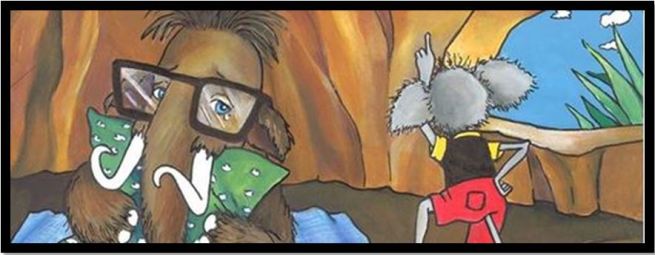
The text is long. Little kids will have a tough time keeping their attention on the story. The story needs tightened to reduce redundancy, correct punctuation errors, and help the story move along smoothly. Plus, a credit page needs added to the front. Before—on occasion after— a character speaks, the narrator explains what the character will say and why. This happens so often it becomes annoying. It is not necessary to alert the reader to what the character will say or why and then have the character repeat, sometimes verbatim, what the narrator just explained. I felt like the narrator did not trust that readers would catch on to the story.
Betty also explained that she wanted to get to know Trevor a little better.
Betty smiling at Trevor said, “And one other thing Trevor, I would like to get to know you a little better. Most of us don’t know you very well either.”
There were many books about bullies last year and more on the way this year. Windsor the Bullied Wooly Mammoth may be the most ambitious. Usually, we learn about the bullied, how they are bullied, and what to do about that bully. Windsor the Bullied Wooly Mammoth also lets us know how those witnessing the bullying, but not part of it, feel and how they can help, plus why the bully acts as he or she does. Every angle is covered.
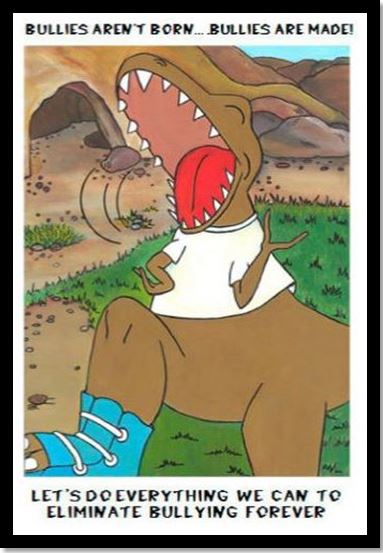
The large sized book has great illustrations on one-half of the spread. The dinosaur and the mouse are cute with their big bright eyes. The dinosaurs have cherry-bright tongues and have different colored complexions. Windsor is the only one to wear eyeglasses and look geeky. He really is out of place in this dinoland. Kids will enjoy the illustrations. The art draws your eye to that side of the spread every time. The back of the cover has a laughing Trevor with the words, “Bullies aren’t born . . . bullies are made!”
.
Learn more about Windsor the Bullied Wooly Mammoth HERE.
Buy Windsor the Bullied Wooly Mammoth at Amazon—B&N—Createspace—ask your local bookstore
.
Links for the author, Keith Lohnes: blog facebook createspace
Links for illustrator, Linda Manne: flickr freelanced
WINDSOR THE BULLIED WOOLY MAMMOTH. Text copyright © 2013 by Keith Lohnes. Illustrations copyright © 2013 by Linda Manne. Reproduce by permission of the author, Keith Lohnes.
.

.mmkdmfkdmf
Since I'm the last of us to blog about bullying, I wanted to end on a positive note. Although bullying is as awful here as anywhere else, something great happened in our school district recently that was like the first star shining in a black night sky. So who's up for a feel-good story?
The high school from which my kids graduated is in a nearby small town. Graduating classes average 200-225 seniors. Homecoming week is special. A student government-led food drive kicks off in a big way. A parade winds through streets lined with red-clad crowds cheering the marching band, floats from every conceivable club, clusters of elementary school walkers, etc. School spirit runs high through many long-held traditions. The entire week has a very Norman Rockwell-ish feel to it.
The selection of Homecoming King and Queen, though, is mostly a popularity contest. No surprise there. This year, though, one of the guys the student body included on the court was a special needs student, Alex (not his real name). Alex is the kind of guy who knows and loves everybody. When he walks the halls, he's constantly shouting greetings, high-riving and flashing his bright smile. A staff member at the high school describes him as "always positive, always happy, always genuine."
Alex's parents nixed his participation in one Homecoming week tradition: The 24 kids on the court spend the evenings leading up to Friday night's game TPing each other's houses. (The police pretty much look the other way, as they have for years and years. I know. Weird.) Since Alex couldn't be included in these hijinks, the other guys on the court arrived at his home on Thursday night and (prearranged with his parents) surprised him with a trip to a bowling alley. While he was gone, the 12 girls on the court (again, with his parents' okay) swooped in to decorate the inside of Alex's home and hang a big CONGRATS poster. Pretty cool.
Then the student body pulled off something that knocked the collective socks off the community. When the candidates lined up on the sideline during halftime of the big game, the king's crown was placed upon the unsuspecting head of . . . Alex.
 Now
meet Jack’s creator, Susanne Gervay, the award-winning, Order of Australia for
Literature author whom I proudly call friend, colleague and SCBWI Kin. (Susanne
serves as the Regional Advisor for SCBWI’s Eastern Australia and New ZealandChapter.)
Now
meet Jack’s creator, Susanne Gervay, the award-winning, Order of Australia for
Literature author whom I proudly call friend, colleague and SCBWI Kin. (Susanne
serves as the Regional Advisor for SCBWI’s Eastern Australia and New ZealandChapter.)
.
Breaking News:
This is a book I have been meaning to read for quite some time now. The Big Splash is a book that has a constant and steady flow of readers at our school. I enjoyed it very much, but somehow I had not gotten around to reading the sequel. Boy, I'm glad I finally did!
I first read about this book over at Ms. Yingling's blog. Romance is always a bit of a tricky thing in that I tend to find them super girly or super sexy. Farrar has hit the mark with A Song for Bijou in that it offers a boy's point of view without going into the realm of YA.
It was particularly difficult—and yet so important and poignant—to read K.M. Walton's second novel, Empty, late last night and into this early morning. Kate is a friend of mine, a deep-thinking, big-hearted former school teacher who has devoted her novelistic life (so far) to making visible the too-often invisible lives of young people who have either been bullied or succumbed to the tease of hurting others. In a recent, moving TEDx talk, Kate took us back into her teaching days and shared her effective cure for getting kids to stop hurting other kids. It's mandatory watching.
What an amazing story my friend KM Walton tells here about saving a bullied boy from those who tormented him. She taught empathy. She gave bullies the power of kindness. Listen in.
4 Stars We're All Different But We're All Kitty Cats Peter Goodman Nicholas Milano No. Pages: 4 Ages: 4+ ................... Inside Jacket: “My name is Carlos and I have no fur.” A kitty with no fur? How strange, thought the other cat, laughing and giggling at Carlos. Hurt and embarrassed in front of the class, [...]![]()
5 Stars Otter Lee Brave Rena Cherry Brown Schiffer Publishing No. Pages: 48 Ages: 5 to 10 ..................
Lee, a young otter, loses his mother and finds himself in a rescue aquarium where he meets a bully, learns to trust human beings, survives a catastrophe, and, by recalling his mother’s lessons, makes a tough decision that ultimately changes his life.
Lee is a young pup, beginning to learn his way around the bay with his mother as his teacher. He wants to dive deep and bring back clams, impressing his mother, but little Lee think he is too small to dive so deep. His mother tells him,
You don’t have to be big to be brave.
While lying serenely on the water, a dark shadow appears above them. Lee’s mother yells for him to dive to the floor of the bay. Lee dives deep, all the way to the sandy floor. Swimming back to the water’s surface Lee looks for his mother, he cannot find her. She is trapped in a fishing net at the bottom of the bay. Days later, an otter rescue boat picks up Lee and takes him to their aquarium, where he can continue to grow. Without his mother, Lee is an orphan.
dives deep, all the way to the sandy floor. Swimming back to the water’s surface Lee looks for his mother, he cannot find her. She is trapped in a fishing net at the bottom of the bay. Days later, an otter rescue boat picks up Lee and takes him to their aquarium, where he can continue to grow. Without his mother, Lee is an orphan.
At the aquarium, a bully keeps Lee from eating, grabbing away anything within Lee’s reach. This bully, named Brody, taunts Lee in the water. When an earthquake hits the area, the aquarium bursts open, dumping all the otters in the bay. Lee is the only otter born at sea. The others do not know what to do.
Lee tells everyone to link together, but Brody laughs and dives deep into the water. Soon the rescue group has rescued all the otters— except Brody. He never linked up. Lee dives down to the floor looking for Brody and finds him caught under a fishing net. Lee has a tough choice to make. He can ignore Brody and be free of the bully forever, or he can rescue him and be at his mercy once again.
except Brody. He never linked up. Lee dives down to the floor looking for Brody and finds him caught under a fishing net. Lee has a tough choice to make. He can ignore Brody and be free of the bully forever, or he can rescue him and be at his mercy once again.
Otter Lee Brave is a good story for any child who has experienced bullying. Brody is the typical bully, be it an otter or a kid. He is mean to those smaller than he is which helps him with his low self-esteem. Lee is a cute, lovable character kids will adore. Some will even identify with him, others with Brody. Lee does his best to avoid the bully, but eventually must stand up to him. That is a terrifying moment and kids will understand Lee’s thoughts about leaving Brody where he was, trapped under water. The writing is wonderful. Kids will get a story and a primer on otters.
The illustrations are dramatic and help draw you into the story emotionally. The first page sets the scene.  Lee is lying on the water and you can feel the waves rocking him gently. When Brody splashes in the bay, the water flies around him. Being in the bay, the illustrations rely on blues and greens, which the illustrator uses deftly to make the water come alive.
Lee is lying on the water and you can feel the waves rocking him gently. When Brody splashes in the bay, the water flies around him. Being in the bay, the illustrations rely on blues and greens, which the illustrator uses deftly to make the water come alive.
Otter Lee Brave is a good book for teachers. Students learn about otters, see them in the bay and at a rescue. Learn facts like a life span that averages ten to twelve years, even though they can live to be twenty-five-years-old. That fact is a great discussion question. I think kids will love Lee’s story.
Otter Lee Brave is a well-written, emotional story with stunning illustrations complimenting it on every page. I immensely enjoyed this picture book. The story combined with the illustrations make Otter Lee Brave a richly told story with drama, emotion, and heart. This is Ms. Brown’s second children’s book, both illustrated by Ms. Maidment. This is sure to be an award-winning book.
There are additional otter facts in the back of the book. Kids could easily use Otter Lee Brave as part of a project or paper on otters.
……………………………..
Author: Rena Cherry Brown website Illustrator: Mikaila Maidment website Publisher: Schiffer Publishing website Release Date: July 28, 2012 ISBN: 978-0-7643-4155-7 Number of Pages: 48 Ages: 5 to 10 Grades: K to 5 .............................
Yesterday I wrote a "review" of R.J. Palacio's Wonder wherein I was trying to work out what I was thinking on the fly, on the screen, sorting out my thoughts in public. even as I was committing the post to go public I was still left with the feeling that I hadn't really scratched the surface. I've been trying to stay as close to gut-level in my reactions while at the same time shortening my
by R.J. Palacio Knopf 2012 Can a boy with a deformed face find friends, happiness, success, and acceptance when he first goes to middle school? Only in a middle grade novel. I'm going to lean a little heavy on this book, despite the fact that I found the writing and narrative structure compelling and well crafted. Bear with me, I'm thinking aloud. There are buses and billboards and junk
|
Title: Keep Holding On Author: Susane Colasanti Publisher: Viking |
May Contain Spoilers
From Amazon:
Noelle’s life is all about survival. Even her best friend doesn’t know how much she gets bullied, or the ways her mom neglects her. Noelle’s kept so much about her life a secret for so long that when her longtime crush Julian Porter starts paying attention to her, she’s terrified. Surely it’s safer to stay hidden than to risk the pain of a broken heart. But when the bullying of her classmate takes a dramatic turn, Noelle realizes it’s time to stand up for herself – and for the love that keeps her holding on.
Review:
This book brought back a lot of unpleasant memories, and I was going to put it down and return it back to the library unread. I remember what it was like to be mercilessly picked on in school, and I wasn’t sure that I wanted a refresher course. I became invested in Noelle’s unhappiness, though, and wondered what she would be able to do to change her circumstances. In addition to having to deal with bullies at school, she also has a nightmare at home. Her mother has been raising her alone, and she is resentful of Noelle. She blames her daughter on her own discontent with her life and her dead end job. She takes her frustrations out on Noelle, and doesn’t care for her. There is never enough food in their cramped rental unit, and her mother’s indifferent eats away at her.
With all of bullying and her mother’s neglect, Noelle feels that she is unlovable. She finds herself in a relationship with a popular boy who is obviously taking advantage of her. He has sworn her to secrecy about their clandestine encounters. They spend the entire time making out. This wasn’t surprising, considering Noelle’s dysfunctional home life. Conversation isn’t something that happens at her house, so why would she expect to actually talk to the boy she has convinced herself that she’s in love with?
When a cute classmate shows some interest in her, Noelle freaks out. Yes, she likes Julian, and yes, she’s dreamed of getting together with him, but she won’t kid herself. Noelle is one of the poorer kids attending her high school, and Julian is from another world. His parents are wealthy, and she just won’t fit into his life. Despite her messed up emotions, Noelle did begin to frustrate me here. Matt was clearly using her, he refused to be seen with her in public, and yet she stubbornly refused to admit to herself that he was taking advantage of her. Their “relationship” didn’t make her happy; it made her miserable that she had to keep it a secret from even her only friend, and yet she continued down a path that she knew was wrong. Instead of giving Julian a chance, she turned him down, without even giving him a chance to prove himself to her. I understood her fe
Add a Comment
4.5 Stars Back Cover: Being mean ain’t in nobody’s blood. Reckon folks will argue that one until there’s no more moonshine on the mountains. But in Freedom Pen that’s what Sarah the Twerp believes. And soon she and her brother, Billy, are setting out on a courageous summertime adventure to free two pit bull pups [...]![]()
4 Stars Tilden Troll didn’t think he was any different from other trolls until he entered the first grade. There, because of his size, he was laughed at and teased by his classmates, who were led by one especially nasty bully. But when the bully found himself in big trouble, only Tilden’s size could save [...]![]()
A to Z Challenge Day23: W . 3 Stars When Grandma’s False Teeth Fly: Katie is not a little girl anymore—she is six years old! But some mean girls at school still tease her about her chipped baby tooth. Katie seeks advice from her grandma, who will tell her a hilarious story that encourages her to use [...]![]()
Thank you, Jill, for sharing your town's - and Alex's - story.
It's not only a "feel-good" story; it's the perfect "Show, Don't Tell" story to punctuate our posts that highlighted National Bully Prevention Month.
(Think exclamation mark!)
Wonderful story, Jill. Thanks so much for ending our series in a positive way.
Thanks for posting that, Jill. A great story!
This made my day!
Thanks, Esther, Marti, and Pat. Penny, it made mine, too! :)
Thank you for posting this stunning story, Jill. Just goes to show that when you let in the light, the darkness is gone. These kids are truly an inspiration.
A wonder-filled, hopeful story. This event will carve a memory for those kids forever.
Anne, I couldn't agree more. Margaret, I hope it has a pay-it-forward affect on everybody involved.
Jill
So glad I finally got to your post, Jill. Thank you for sharing this story. After hearing the national news of another 'sad' story, I am happy to hear yours. I hope the awareness of this month helps in many ways! Thanks!
I know, Linda. So sad to hear yet another heartbreaking story in the news...